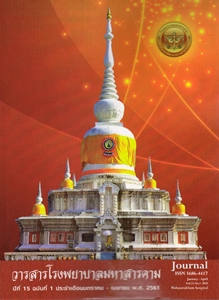ปัจจัยที่มีความสัมพันธ์ต่อผลลัพธ์ของการได้รับยาละลายลิ่มเลือดในผู้ป่วยโรคหลอดเลือดสมองชนิดขาดเลือดเฉียบพลันในโรงพยาบาลมหาสารคาม
บทคัดย่อ
วัตถุประสงค์: เพื่อศึกษาปัจจัยที่มีความสัมพันธ์ต่อผลลัพธ์ของการได้รับยาละลายลิ่มเลือดในผู้ป่วยโรคหลอดเลือดสมองชนิดขาดเลือดเฉียบพลัน
วิธีดำเนินการวิจัย: รูปแบบการศึกษาแบบ Retrospective cohort study โดยรวบรวมผู้ป่วยโรคหลอดเลือดสมองชนิดขาดเลือดเฉียบพลันที่ได้รับยาละลายลิ่มเลือดจากเวชระเบียนของผู้ป่วยที่เข้ารับการรักษาในโรงพยาบาลมหาสารคามทั้งหมดตั้งแต่วันที่ 1 ตุลาคม 2557ถึงวันที่ 30 กันยายน 2560 สถิติที่ใช้ในการวิเคราะห์ได้แก่ สถิติเชิงพรรณา การวิเคราะห์ตัวแปรเชิงเดี่ยว และการวิเคราะห์ถดถอยพหุลอจิสติก โดยกำหนดระดับนัยสำคัญที่ p-value <0.05
ผลการวิจัย : ผู้ป่วยทั้งหมด144 คน ผลลัพธ์การรักษาที่ได้ผลดีร้อยละ53.5 เสียชีวิตร้อยละ20.1 มีภาวะเลือดออกในสมองที่ก่อให้เกิดอาการร้อยละ8.3 ปัจจัยที่มีความสัมพันธ์ต่อภาวะเลือดออกในสมองที่ก่อให้เกิดอาการได้แก่ อายุ >80ปี (OR Adj. = 9.25; 95%CI: 2.04-41.97) โรคหลอดเลือดสมองอุดตันที่ไม่ใช่เส้นเล็ก (OR Adj. = 4.36 95;%CI: 1.12-25.12) ระดับน้ำตาล>150mg/dl (OR Adj. = 4.36 ; 95%CI: 1.44-13.18) ปัจจัยที่มีความสัมพันธ์ในเชิงผกผัน(inverse)ต่อการเสียชีวิตภายใน 3 เดือน ได้แก่ ASPECT score>8 (OR Adj. = 0.302; 95%CI: 0.097-0.941) ระดับน้ำตาล <150mg/dl (OR Adj. = 0.113; 95%CI: 0.038-0.337) อายุ<80ปี (OR Adj. = 0.058; 95%CI: 0.007-0.473) ปัจจัยที่มีความสัมพันธ์การรักษาที่ได้ผลดีได้แก่ ASPECT score>8 (OR Adj. = 4.13; 95%CI: 1.45-11.78) การที่ภาพถ่ายทางรังสีไม่พบ proximal hyperdense MCA (OR Adj. = 4.71; 95%CI: 1.37-16.23) ระดับน้ำตาล<150mg/dl (OR Adj. = 3.59; 95%CI: 1.53-8.46)
สรุป: การศึกษานี้แสดงให้เห็นว่าผู้ป่วยที่มีอายุมากกว่า 80 ปี โรคหลอดเลือดสมองอุดตันที่ไม่ใช่เส้นเล็ก ระดับน้ำตาลมากกว่า 150mg/dl เป็นปัจจัยที่มีความสัมพันธ์ต่อภาวะเลือดออกในสมองที่ก่อให้เกิดอาการ ส่วน ASPECT score>8 ระดับน้ำตาล <150mg/dl อายุน้อยกว่า 80ปี เป็นปัจจัยเชิงผกผันต่อการเสียชีวิตภายใน 3 เดือน ส่วน ASPECT score>8 การที่ภาพถ่ายทางรังสีไม่พบ proximal hyperdense MCA และ ระดับน้ำตาล<150mg/dl เป็นปัจจัยที่มีความสัมพันธ์การรักษาที่ได้ผลดี
คำสำคัญ: โรคหลอดเลือดสมองชนิดขาดเลือดเฉียบพลัน ยาละลายลิ่มเลือด ผลลัพธ์การรักษา
เอกสารอ้างอิง
Klungman P, Saengsuwan J. Selected factors associated with seeking treatment after the onset acute stroke elderly patients. J Nurs Assos Thai, North-Eastern Division. 2012; 30 (4): 141-6.
Eissa A, Krass I, Bajorek BV, Optimizing the management of acute ischemic stroke:a review of utilization of intravenous recombinant tissue plasminogen activatior(tPA). J Clin Pharm Ther. 2012; 37(6): 620-9.
Ringleb PA, Schellinger PU, Schranz C, Hacke W. Thrombolytic therapy within 3to6 hours after onset of ischemic stroke: useful or harmful? Stroke. 2002; 33(5): 1437-41.
The NINDS t-PA Stroke Study. Intracrebral hemorrhage after intravenous t-PA therapy for ischemic stroke. Stroke; 1997;28(11):2109-18.
Lakeskrewee T, Meungtaweepongsa S, Patumanond J, Tiamkao S, Thamnangraksat T, Phankhian P, et-al. Prognostic parameter for symptomatic intracranial hemorrhage after intravenous thrombolysis in acute ischemic stroke in an Asian population. Curr Neurovsc Res. 2017;14(2):169-176.
Al-Khaled M, Matthis C, Eggers J. Predictors of in-hospital mortality and the risk of symptomatic intracerebral hemorrhage after thrombolytic therapy with recombinant tissue plasminogen activator in acute ischemic stroke. J Stroke Cerebrovasc Disc. 2014; 23 (11):7-11.
Liu M, Pan Y, Zhou L, Wang Y. Predictors of post-thrombolysis symptomatic intracranial hemorrhage in Chinese patients with patients with acute ischemic stroke. PLoS One. 2017;12(9):152-6
Meungtaweepongsa S, Prapa-Annantachai P, Dharmasaroja pA, Rukkul P, Yodsitsak P. External validatin of the SEDAN score: the real world practice of a single center. Ann Indian Acad Neurol. 2015; 18(2):181-6
Menon BK, Sava JL, Prabhakaran S, Reeeves M, Liang L, Olsan DM, et-al. Risk score for intracranial hemorrhage in patients with acute ischemic stroke treated with intravenous tissue-type plasminogen activator. Stroke. 2012; 43: 2293-9.
Heuschmann PU, Kalominsky-Rabas PL, Roether J, Misselwitz B, Lowitsch K, Heidrich J, et-al. Predictors of in-hospital mortality in patients with acute ischemic stroke treated with thrombolytic therapy. JAMA. 2004; 292(150: 1831-8.
Ahmed N, Lees KR, Ringleb PA, Bladin C, Collas D,Toni D, et al. Outcome after stroke thrombolysis in patients>80 years treated within 3 hours vs >3-4.5hours. Neurology. 2017; 89(15): 1561-8.
Capse SE, Hunt D, Malamberg K, Pathak P, Gastein HC. Stress hyperglycemia and prognosis of stroke in nondiabetic and diabetic patients: a systemic overview. Stroke. 2001; 32(10); 2426-32.
Yong M, Kaste M. Dynamic of hyperglycemia as a predictor of stroke outcome in the ECASS-II trial. Stroke. 2008; 39(10): 2749-55.
Barber PA, Demchuk AM, Zhang J. Validity and reliability of a quantitative computed tomography score in predicting outcome in hyperacute stroke before thrombolytic therapy. Lancet. 2000; 355: 1670-4
Demchuk AM, Hill MD, Barber PA, Silver B, Patel SC, Levine SR. Importance of early ischemic computed tomography changes using APECTS in NINDs rt-PA Stroke study. Stroke. 2005; 36: 2110-5.
Li Q, Davis S, Mitchell P, Dowling R, Yan B. Proximal hyperdense middle cerebral artery sign predicts poor response to thrombolysis. PLoS One. 2014;1:121-8
Bruno A, Liebeskind D, Hau Q, Raycher R. Investigators US diabetes mellitus, acute hyperglycemia and ischemic stroke. Curr Treat Options Neuol. 2010; 12(6): 492-503.
Calleja AI, Gurcia-Bermaja P, Cortijo E, Bustamante R, Raja Martinez E, Gazalez Sarmuento E, et-al. Insulin resistance is associated with a poor response to intravenous thrombolysis in acute ischemic stroke. Diabetes Care. 2011; 34(11): 2413-7.
Cosentino F, Battista R, Scuteri A, De Sensi F, De Siati R, Di Russo A, et-al. Impact of fasting glycemia and regional cerebral perfusion in diabetic subjects: a study with technetium-99m-ethyl cysteinte dimer single photon emission computed tomography. Stroke. 2009; 40 (1): 306-8.
Rao AK, Chouhan V, Chen X, Sun L, Boden G. Activation of the tissue factor pathway of blood coagulation during prolonged hyperglycemia in young healthy men. Diabetes. 1999; 48(50: 1156-61.
Pandolfi A, Giaccari A, Cilli C, Alberta MM, Marviducci L, De Filippis EA, et-al. Acute hyperglycemia and acute hyperinsulinemia decrease plasma fibrinolytic activity and increase plasminogen activator type 1 in the rat. Acta Diabetol. 2001; 38(2): 71-6.
ดาวน์โหลด
เผยแพร่แล้ว
รูปแบบการอ้างอิง
ฉบับ
ประเภทบทความ
สัญญาอนุญาต
วารสารนี้เป็นลิขสิทธิ์ของโรงพยาบาลมหาสารคาม






